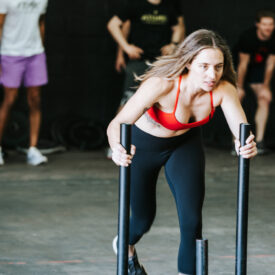There are two constraints which limit our training, and therefore, our progress:
- Available training time
- The ability to recover
Time
A person only has so much time to allocate to physical training. Most people have between 2-6 hours per week to dedicate to physical improvement. Work, family, and other activities limit how much time we can spend pursuing higher levels of fitness.
Ability to Recover
Those of us not limited by time constraints will be limited by our body’s ability to recover from training.
With this in mind, each of us possess a set amount of training time allocated by our schedule or body.
Seeing as how you cannot train 20 hours per week, and recover sufficiently, you must decide how to allocate training time.
You must make a decision to be a generalist or a specialist.
A generalist demonstrates a well-rounded level of fitness, while the specialist excels in one aspect of it.
The Generalist
Typically the generalist will have more varied training and will improve multiple attributes simultaneously. Since this athlete trains multiple attributes at once, less work is dedicated to each attribute. Less training dedicated to each attribute means the rate of improvement will be slower.
To illustrate:

The generalist allocates 30-60 minutes towards 5 different attributes. This is enough volume for new and intermediate athletes to see improvement, but experienced athletes training at this volume would only maintain existing fitness.
The Specialist
A specialist, on the other hand, will train more specifically and oftentimes repetitively. They will dedicate a larger portion of their available training time improving a single attribute. The result yields a much faster rate of improvement in the targeted attributes.
Let’s looks at a specialist’s sample week.

It is obvious that by the end of a 1-3 month training cycle, the specialist’s maximal strength will improve much more than the generalist’s. Why? The specialist focused Maximal Strength with four times the volume of the generalist.
Volume and Intensity
It is important to understand a critical concept that applies to all training:
Intensity dictates the type of adaptation.
Volume dictates how much adaptation.
Let’s explore this idea briefly:
Two athletes trying to improve their conditioning both go run at a pace corresponding with 55-75% of their max heart rate.
This intensity (running pace relative to HR) creates specific aerobic adaptations such as increased aerobic enzymes, increased capillarization, and mitochondrial density. If they ran faster or slower (different intensity), then the adaptation would be different.
Athlete A runs 2x a week for 30 minutes for a total of 60 minutes.
Athlete B runs 4x a week for 45 minutes for a total of 180 minutes.
Athlete B is getting 3x as much volume as Athlete A and will therefore acquire more adaptation. They will have better capillarization, more mitochondria, and more aerobic enzymes. Because they did more work they got more reward.
The more you do something, the more results you will get from it.
You have to make a decision
We’d all like to squat 400+ pounds and run a sub-5-minute mile but to do both at the same time is an unreasonable goal for 99.9% of the population.
You must decide what exactly you want to achieve with your training.
Do you want to excel at one aspect? Then you must be willing to let some others slide and sacrifice variety.
Do you want to be well-rounded in all aspects? Then you must understand improvement will come slower.
Only one person can have it all, and he’s from Krypton.




